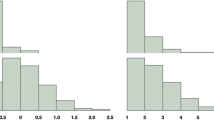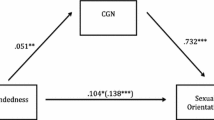Abstract
Two studies were undertaken to confirm the previous findings that homosexual men in general tend to have a later than expected birth order and that extremely feminine homosexual men also tend to have a higher than expected proportion of brothers (i.e. a highersibling sex ratio). Subjects in Study 1 were Dutch, adult and adolescent, biological male patients with gender dysphoria (persistent and recurrent desires to belong to the opposite sex), who were undergoing treatment with feminizing hormones. These comprised 83 patients who reported sexual attraction to other males (the homosexual group) and 58 who reported sexual attraction to females or equal attraction to males and females (the nonhomosexual group). Subjects in Study 2 were Dutch adolescent male patients at another hospital. The homosexual group consisted of 21 gender-dysphoric homosexual teenagers referred to a gender identity clinic for children and adolescents. The control group were 21 adolescent males referred to the child psychiatry department of the same hospital for reasons other than gender identity disorder, homosexuality, or transvestism. These were individually matched to the homosexual subjects on age and sibship size. In both studies, the homosexual group had a significantly later average birth order than the comparison group. In Study 1, the homosexual group had a significantly elevated sibling sex ratio; this was not tested in Study 2 because of its small sample size. These studies add to the mounting evidence that late birth orders are common to all homosexual samples and that elevated sibling sex ratios are an additional characteristic of extremely feminine ones.
Similar content being viewed by others
References
Ackerman-Ross, S., and Khanna, P. (1989). The relationship of high quality day care to middle-class 3-year-olds' language performance.Early Childhood Research Quarterly 4: 97–116.
American Psychiatric Association. (1987).Diagnostic and Statistical Manual of Mental Disorders, 3rd ed., rev., American Psychiatric Association, Washington, DC.
Bailey, J. M., and Pillard, R. C. (1991). A genetic study of male sexual orientation.Arch. Gen. Psychiat. 48: 1089–1096.
Bailey, J. M., and Zucker, K. J. (1995). Childhood sex-typed behavior and sexual orientation: A conceptual analysis and quantitative review.Dev. Psychol. 31: 43–55.
Berglin, C. G. (1982). Birth order as a quantitative expression of date of birth.J. Epidemiol. Commun. Health. 36: 298–302.
Berglin, C. G. (1985). Male antigenicity and parity.Behav. Brain Sci. 8: 442–443.
Bigner, J. J. (1972). Sibling influence on sex-role preference of young children.J. Genet. Psychol. 121: 271–282.
Bijur, P. E., Golding, J., and Kurzon, M. (1988). Childhood accidents, family size and birth order.Soc. Sci. Med. 26: 839–843.
Birtchnell, J. (1971). Birth rank and mental illness.Nature 234: 485–487.
Blanchard, R. (1985). Typology of male-to-female transsexualism.Arch. Sex. Behav. 14: 247–261.
Blanchard, R. (1988). Nonhomosexual gender dysphoria.J. Sex Res. 24: 188–193.
Blanchard, R. (1989a). The classification and labeling of nonhomosexual gender dysphorias.Arch. Sex. Behav. 18: 315–334.
Blanchard, R. (1989b). The concept of autogynephilia and the typology of male gender dysphoria.J. Nerv. Ment. Dis. 177: 616–623.
Blanchard, R. (1993a). The she-male phenomenon and the concept of partial autogynephilia.J. Sex Marital Ther. 19: 69–76.
Blanchard, R. (1993b). Partial versus complete autogynephilia and gender dysphoria.J. Sex Marital Ther. 19: 301–307.
Blanchard, R., and Bogaert, A. F. (1996). Homosexuality in men and number of older brothers.Am. J. Psychiat. 153: 27–31.
Blanchard, R., and Bogaert, A. F. (in press). Biodemographic comparisons of homosexual and heterosexual men in the Kinsey interview data.Arch. Sex. Behav.
Blanchard, R., and Sheridan, P. M. (1992). Sibship size, sibling sex ratio, birth order, and parental age in homosexual and nonhomosexual gender dysphorics.J. Nerv. Ment. Dis. 180: 40–47.
Blanchard, R., and Zucker, K. J. (1994). Reanalysis of Bell, Weinberg, and Hammersmith's data on birth order, sibling sex ratio, and parental age in homosexual men.Am. J. Psychiat. 151: 1375–1376.
Blanchard, R., Zucker, K. J., Bradley, S. J., and Hume, C. S. (1995). Birth order and sibling sex ratio in homosexual male adolescents and probably prehomosexual feminine boys.Dev. Psychol. 31: 22–30.
Bourguet, C. C., and McArtor, R. E. (1989). Unintentional injuries: Risk factors in preschool children.Am. J. Dis. Child. 143: 556–559.
Brody, C. J., and Steelman, L. C. (1985). Sibling structure and parental sex-typing of children's household tasks.J. Marr. Fam. 47: 265–273.
Brown, L. M., and Weinraub, M. (1980). Sibling status: Implications for sex-typed toy preferences and awareness of sex-role stereotypes in 2- to 3-year-old children. Unpublished manuscript, Temple University, Philadelphia, PA.
Camilleri, A. P., and Cremona, V. (1970). The effect of parity on birthweight.J. Obstet. Gynaecol. Br. Commonwealth 77: 145–147.
Chahnazarian, A. (1988). Determinants of the sex ratio at birth: Review of recent literature.Soc. Biol. 35: 214–235.
Cobb, J. A. (1914). The alleged inferiority of the first-born.Eugenics Rev. 5: 357–359.
Cohen, J. (1988).Statistical Power Analysis for the Behavioral Sciences, 2nd ed., Erlbaum, Hillsdale, NJ.
Cohen, S. E., and Beckwith, L. (1977). Caregiving behaviors and early cognitive development as related to ordinal position in preterm infants.Child Dev. 48: 152–157.
Diamond, M., Rust, N., and Westphal, U. (1969). High-affinity binding of progesterone, testosterone and cortisol in normal and androgen treated guinea pigs during various reproductive stages: Relationship to masculinization.Endocrinology 84: 1143–1151.
Green, R. (1987).The “Sissy Boy Syndrome” and the Development of Homosexuality, Yale University Press, New Haven, CT.
Grotevant, H. D. (1978). Sibling constellations and sex-typing of interests in adolescence.Child Dev. 49: 540–542.
Gualtieri, T., and Hicks, R. E. (1985). An immunoreactive theory of selective male affliction.Behav. Brain Sci. 8: 427–441.
Hamer, D. H., Hu, S., Magnuson, V. L., Hu, N., and Pattatucci, A. M. L. (1993). A linkage between DNA markers on the X-chromosome and male sexual orientation.Science 261: 321–327.
Hare, E. H., and Moran, P. A. P., (1979). Parental age and birth order in homosexual pateints: A replication of Slater's study.Br. J. Psychiat. 134: 178–182.
Hare, E. H., and Price, J. S. (1969). Birth order and family size: Bias caused by changes in birth rate.Br. J. Psychiat. 115: 647–657.
Hare, E. H., and Price, J. S. (1974). Birth order and birth rate bias: Findings in a representative sample of the adult population of Great Britain.J. Biosoc. Sci. 6: 139–150.
Horwitz, S. M., Morgenstern, H., DiPietro, L., and Morrison, C. L. (1988). Determinants of pediatric injuries.Am. J. Dis. Child. 142: 605–611.
Jagers, P. (1982). How probable is it to be first born? and other branching-process applications to kinship problems.Math. Biosci. 59: 1–15.
James, W. H. (1987a). The human sex ratio. Part 1: A review of the literature.Hum. Biol. 59: 721–752.
James, W. H. (1987b). The human sex ratio. Part 2: A hypothesis and a program of research.Hum. Biol. 59: 873–900.
James, W. H. (1990). The hypothesized hormonal control of human sex ratio at birth—an update.J. Theoret. Biol. 143: 555–564.
James, W. H. (1992). The hypothesized hormonal control of mammalian sex ratio at birth—a second update.J. Theoret. Biol. 155: 121–128.
Jensch, K. (1941). Weiterer Beitrag zur Genealogie der Homosexualität [A further contribution to the genealogical study of homosexuality].Arch. Psychiat. Nervenkr. 112: 679–696.
Kallmann, F. J. (1952). Twin and sibship study of overt male homosexuality.Am. J. Hum. Genet. 4: 136–146.
Katz, P. A., and Boswell, S. L. (1984). Sex-role development and the one-child family. In Falbo, T. (ed.),The Single-Child Family, Guilford, New York, pp. 63–116.
Koch, H. L. (1956). Sissiness and tomboyishness in relation to sibling characteristics.J. Genet. Psychol. 88: 231–244.
Lang, T. (1940). Studies on the genetic determination, of homosexuality.J. Nerv. Ment. Dis. 92: 55–64.
Lang, T. (1960). Die Homosexualität als genetisches Problem [Homosexuality as a genetic problem].Acta Genet. Med. Gemellol. 9: 370–381.
Laosa, L. M., and Brophy, J. E. (1972). Effects of sex and birth order on sex-role development and intelligence among kindergarten children.Dev. Psychol. 6: 409–415.
Leventhal, G. S. (1970). Influence of brothers and sisters on sex-role behavior.J. Pers. Soc. Psychol. 16: 452–465.
Lewis, M., and Kreitzberg, V. S. (1979). Effects of birth order and spacing on mother-infant interactions.Dev. Psychol. 15: 617–625.
Libber, S. M., and Stayton, D. J. (1984). Childhood burns reconsidered: The child, the family, and the burn injury.J. Trauma 24: 245–252.
MacCulloch, M. J., and Waddington, J. L. (1981). Neuroendocrine mechanisms and the aetiology of male and female homosexuality.Br. J. Psychiat. 139: 341–345.
Manheimer, D. I., Dewey, J., Mellinger, G. D., and Corsa, L. (1966). Fifty thousand child-years of accidental injuries.Public Health Rep. 81: 519–533.
Martin, J. F. (1994). Changing sex ratios: The history of Havasupai fertility and its implications for human sex ratio variation.Curr. Anthropol. 35: 255–266.
Meulenberg, P. M. M., and Hofman, J. A. (1991). Maternal testosterone and fetal sex.J. Steroid Biochem. Molec. Biol. 39: 51–54.
Money, J., and Lamacz, M. (1984). Gynemimesis and gynemimetophilia: Individual and crosscultural manifestations of a gender-coping strategy hitherto unnamed.Comprhen. Psychiat. 25: 392–403.
Moore, D. H., and Gledhill, B. L. (1988). How large should my study be so that I can detect an altered sex ratio?Fertil. Steril. 50: 21–25.
Nixon, J., and Pearn, J. (1978). An investigation of socio-demographic factors surrounding childhood drowning accidents.Soc. Sci. Med. 12: 387–390.
Pauly, I. B. (1992). Terminology and classification of gender identity disorders.J. Psychol. Hum. Sex. 5: 1–14.
Price, J. S., and Hare, E. H. (1969). Birth order studies: Some sources of bias.Br. J. Psychiat. 115: 633–646.
Schachter, F. F. (1982). Sibling deidentification and split-parent identification: A family tetrad. In Lamb, M. E., and Sutton-Smith, B. (eds.),Sibling Relationships, Erlbaum, Hillsdale, NJ, pp. 123–151.
Sieff, D. F. (1990). Explaining biased sex ratios in human populations: A critique of recent studies.Curr Anthropol. 31: 25–35.
Slater, E. (1958). The sibs and children of homosexuals. In Smith, D. R., and Davidson, W. M. (eds.),Symposium on Nuclear Sex, Heinemann, London, pp. 79–83.
Slater, E. (1962). Birth order and maternal age of homosexuals.Lancet 1: 69–71.
Suarez, B. K., and Przybeck, T. R. (1980). Sibling sex ratio and male homosexuality.Arch. Sex. Behav. 9: 1–12.
Sutton-Smith, B., Roberts, J. M., and Rosenberg, B. G. (1964). Sibling associations and role involvement.Merrill-Palmer Quart. 10: 25–38.
Vroegh, K. (1971). The relationship of birth order and sex of siblings to gender role identity.Dev. Psychol. 4: 407–411.
West, D. J. (1977).Homosexuality Re-examined, University of Minnesota Press, Minneapolis.
Whitam, F. L., Diamond, M., and Martin, J. (1993). Homosexual orientation in twins: A report on 61 pairs and three triplet sets.Arch. Sex. Behav. 22: 187–206.
Whitam, F. L., and Zent, M. (1984). A cross-cultural assessment of early cross-gender behavior and familial factors in male homosexuality.Arch. Sex. Behav. 13: 427–439.
Zucker, K. J., and Blanchard, R. (1994). Reanalysis of Bieber et al.'s 1962 data on sibling sex ratio and birth order in male homosexuals.J. Nerv. Ment. Dis. 182: 528–530.
Author information
Authors and Affiliations
Rights and permissions
About this article
Cite this article
Blanchard, R., Zucker, K.J., Cohen-Kettenis, P.T. et al. Birth order and sibling sex ratio in two samples of Dutch gender-dysphoric homosexual males. Arch Sex Behav 25, 495–514 (1996). https://doi.org/10.1007/BF02437544
Issue Date:
DOI: https://doi.org/10.1007/BF02437544




